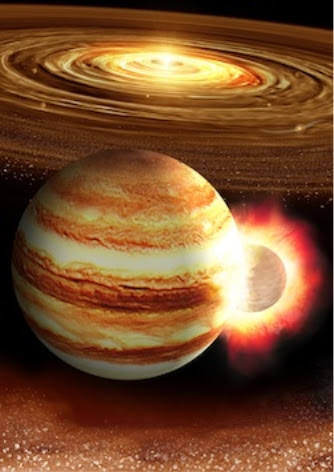It's found some mysterious gravitational readings which experts infer mean Jupiter's core is less dense and more extended that expected.
Jupiter began as a dense, rocky or icy planet that later gathered its thick atmosphere from the primordial disk of gas and dust that birthed our sun so what if the recent data could be explained by a giant impact that stirred Jupiter's core, mixing the dense contents of its core with less dense layers above. Like another planet.

Artist rendering of a collision between a young Jupiter and a massive still-forming protoplanet in the early solar system. Illustration by K. Suda&Y. Akimoto/Mabuchi Design Office, courtesy of Astrobiology Center, Japan
That's the hypothesis of researchers from Rice University and China's Sun Yat-sen University, who ran thousands of computer simulations and found that a fast-growing Jupiter can have perturbed the orbits of nearby "planetary embryos," protoplanets that were in the early stages of planet formation.
The calculations included estimates of the probability of collisions under different scenarios and distribution of impact angles. In all cases, they found there was at least a 40 percent chance that Jupiter would swallow a planetary embryo within its first few million years. In addition, Jupiter mass-produced "strong gravitational focusing" that made head-on collisions more common than grazing ones. Before impact, it might have had a very dense core, but a high mass object with a lot of energy could have been like a bullet that goes through the atmosphere and hit the core head-on . The head-on impact spreads things out, diluting the core.
Impacts at a grazing angle could result in the impacting planet becoming gravitationally trapped and gradually sinking into Jupiter's core, Smaller planetary embryos about as massive as Earth would disintegrate in Jupiter's thick atmosphere.
"The only scenario that resulted in a core-density profile similar to what Juno measures today is a head-on impact with a planetary embryo about 10 times more massive than Earth," said Dr. Shang-Fei Liu of Sun Yat-sen in Zhuhai, China.
Rice astronomer and study co-author Dr. Andrea Isella said the calculations suggest that even if this impact happened 4.5 billion years ago, "it could still take many, many billions of years for the heavy material to settle back down into a dense core under the circumstances suggested by the paper."






Comments